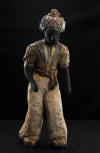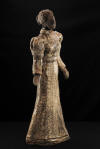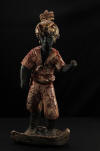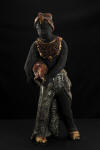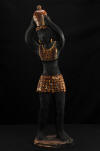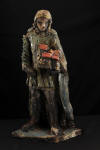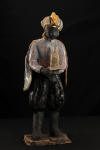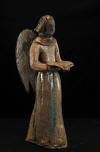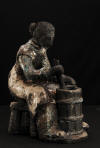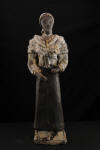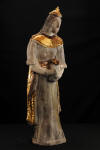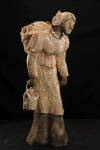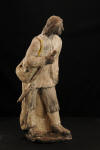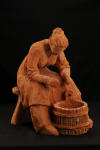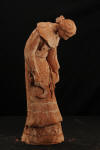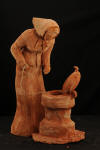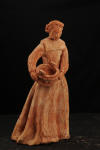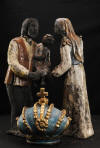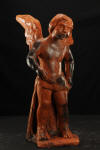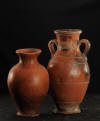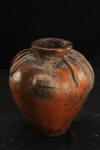Mlikarica,
drvarica, vodarica, žena pere na kablu, „Viktorijanka“
Margareta je u svojoj velikoj tematskoj cjelini „Kako su živjeli i
odjevali se naši stari početkon dvajsetoga vika“prikazala mukotrpan
život ljudi svog grobničkog zavičaja. Tu je prikazala mlikaricu –ženu
simbol, koja je na leđima nosila mlijeko u grad i pješačila 40-tak km da
bi prehranila obitelj. Zatim, ženu koja je na leđima iz šume nosila drva
za ogrijev, ženu koja je robu prala na kablu na dasci.
Međutim za blagdane žene su bile lijepo odjevene po europskoj modi i po
uzoru na viktorijanski stila.
Lattaia, donna
che porta le legna, acquaiola, donna lava allo secchio „la
Vittoriana“.
Nel suo tema „Come vivevano e si vestivano i nostri antenati all'inizio
del XX secolo“ Margareta ha mostrato la vita tribolata del sou paese
nativo Grobnik. Ha mostrato la lattaia –donna simbolo, la quale portava
il latte sulle spalle nella cittá e endava per cca 40 chilometri a piedi
per sostentare la suo famiglia. Poi, la donna che sulle spalle portava
le legna per il riscaldamento dal bosco, la donna che lavava i vestiti
nello secchio sulla tavola. Peró, ai giorni festivi le donne erano
vestite bene, secondo la moda europea e con il stile vittoriano come
modello.
A
milkmaid, a woman gathering firewood,a woman fetching water, a woman
washing clothes in a tub
„a victorian maid“
Magraret, ih her theme entity“How did our ancestors live and dress in
the beginning of the twentieth century“ has shown the drudgery of the
people living in her native – Grobnik. She has displayed the milkmaid a
symbol for a woman who on herback carried milk to the city and walked
over 40 kilometers to provide for her family. Next, a woman who on her
back carried firewood and a woman who washed clothes in a tub using a
scrubbing board.
However, on holidays, the women were well dressed according the the
european fashion and in tehe victorian stiyle.
Milchfrau, Holzirägerin, wasserträgerin cine Frau die im Wassereimer
ihre Wäsche wäscht „Viktorianerin“
Margareta zeigte in ihrer thematischer Einheit „Wie unsere Leuteam
Anfang des zwanzigsten Jahrhundert gelebt haben und wie sie angezogen
waren“ das mühsame Lebenihrer Heimet Grobnik. Hier zeigte sie das Symbol
– die Familie zu ernähren, ca 40 km laufen muBte. Sie zeigte auch die
Frau,die aus dem Wald das Brennholz getragen und auf dem Brett und im
Eimer ihrre Wäasche gewaschen hat.
Aber an Feiertagen, war sic sehr schön angezogen, nach der europäischen
Mode im viktorianiscehn Stil.

„Dondolaši
su bili ljudi koje su vlastelini
iznajmljivali za čuvanje stoke, a oni su zvonjavom plašili zvjeri koje
su se spuštale iz okolnih šuma. Pokriveni životinjskim obilježjima na
glavama, u rukama sjekire, vile a o pojasu vezana zvona. Stari dondolaši
znali su puno puta pored živine potjerati ono zlo koje je prijetilo u
stara vremena Mlečani, Tatari, Turci,… i tako su sačuvali našu slobodu i
hrvatsko ime.
Danas dondolaši u vrijeme karnevala odlaze na različite zabave i
gostovanja prikazujući dio grobničke tradicije…“
„Dondolaši were the people who land-owners could hire to guard
live-stock, and those which through the ringing of their bells would
scare away any beasts which had come out of the surrounding forests.
Adorned with animal markings upon their heads, in their hands axes or
pitch-forks, and with bells fastened to their belts, the old Dondolaši
had to know many more skills besides simply chasing away beasts from
poultry, but also to protect against the evils which threatened us in
the olden times such as thieves, Venetians and Turks... and so the
upheld our freedom and the Croatian name.
Today, the Dondolaši come out at carneval time and with varieties of fun
and entertainment show us a part of Grobnik tradition...“
"Dondolaš-en waren
Menschen die vom Landadel beauftragt waren Vieh zu hüten.Sie haben mit
dem Geläute die Raubtiere aus den umgebenden Wäldern gescheucht.
Dondolaš-en trugen Kopfbedeckung mit tierischen Merkmalen, hielten Axt
und Heugabel in den Händen und hatten Glocken um die Taille gebunden.
Auf diese Art haben die alten Dondolaš-en auβer Raubtiere auch die
andere Übeltäter damaliger Zeit vertrieben-Venezier, Tataren, Türken...und
somit haben sie unsere Freiheit und unseren kroatischen Namen bewahrt.
Heute gehen Dondolaš-en in der Karnevalzeit zu verschiedenen
Festlichkeiten und Veranstaltungen um ein Teil der Grobnik-Tradition
darzustellen..."
Lendu
o Zrinjskom navodi Radmila Matejčić:
„Naziv „mori“ „morčići“ potiče od riječi maurus, Arapin, u dijalektnoj
formi venetskog govora „Moro“. Vrlo je zanimljiva legenda koja
objašnjava kako je u Rijeci došlo do običaja nošenja te vrste nakita.
Prema toj legendi, koja je osobito rasprostranjena u Grobinštini, Turci
su se utaborili na Grobničkom polju i prijetila je opasnost da napadnu
susjednu Rijeku. Zrinjski je s Gradine kod Jelenja odapeo strelicu koja
je pogodila turskog pašu u sljepoočnicu i Turci su se dali u bijeg. Za
sve vrijeme te opsade Riječani su podizali oči k Nebu i molili da
kamenje s neba pobije Turke. I zaista, pri bijegu Turaka počelo je s
neba padati kamenje, koje ih je zatrpalo. Jedino su po polju ostali
njihovi turbani. Kao uspomenu na taj događaj Riječani su svojim ženama
stavili naušnice s glavom pokrivenom turbanom.“
………..
„Morčić je nastao mješavinom kultura Europe i dalekih mističnih
krajeva orijenta. Orijentalni modni ukus 17. i 18. st. načinio je spoj
negroidnih tipova i istočnjačke mode iskazane u neobičnim turbanima,
perju, dragom kamenju, zlatu, srebru i bogatstvu orijentalnog tekstila.
Ti prikazi nisu izmišljeni nego su posljedica aktivne trgovine, time i
kulturnih utjecaja i stalne migracije ljudi. Motiv crnca miješa se i s
Turcima kao posljedica turskih napada pa Turci i crnci bivaju izmješani
da bi se dobio raskošni „moro“. Legendi o postanku morčića ima više a
njihov razvitak pretpostavlja se još iz umjetnosti antičke Grčke ili
umjetnosti egipatske civilizacije.
Margareta Krstić je osmislila i napravila 20 skulptura Morčića za
izložbu Jaslice svijeta u Rijeci, u organizciji Betlehemskog muzeja iz
Betlehema, što su prve skulpture u keramici na ovim područjima uz
skulpture riječkih patricija.“
La legenda di Zrinyi é risportata da Radmila Matejčić
La parola "mori", "moretti" "morčići" deriva dalla parola maurus, arabo, nella forma della parlata venta "moro". Interessantissima la leggenda che ci spiega come venne l´usanza a Fiume di portare questo tipo di gioiello. Secondo questa leggenda, molto diffusa nel Grobniciano, i turchi si accamparono sul campo di Grobnico e la minaccia dell'attacco su Fiume fu imminente. Zrinyi, peró, dalla fortezza di Jelenje lanció una freccia che colpí la tempia del pasciá turco e i turchi si diedero in fuga. Durante l'assedio i fiumani si rivolsero al cielo con la preghiera che i sassi dal cielo uccidano i turchi. E, infatti, durante la fuga dei turchi cominciarono a piovere dal cielo i sassi che li seppellirono.
Sul campo rimasero solo i loro turbanti. In ricordo a questo avvenimento i fiumani misero alle mogli gli orecchini con teste coperte da turbanti.
Legend of Zrinska told by Radmila Matejčić
„The titles 'Mori' or 'Morčić' are derived from the word maurus, Arabian, in a dialectic form of the Venetian 'Moro'. It's a very interesting legend which explains how this particular type of jewelry came to be worn in Rijeka. According to this legend, which is especially prevalent across the region of Grobnik, the Turkish were encamped at Grobničko Polje (Grobnik Plains) posing a dangerous threat of attack upon the neighbouring Rijeka. From the settlements around Jelenje, the people of Zrinska fired arrows which rained down on the pastures below, cutting off the Turks from the safe passage they had given themselves in case of a retreat. Throughout this siege, the Rijekans lifted their eyes to the heavens and prayed that rocks would fall from the sky to kill the Turks. As the withdrawal of the Turks was about to begin, rocks did indeed begin to fall from the skies overwhelming and burying the Turkish. All that remained across the fields were their turbans. As a reminder of these events, the Rijekans adopted ear-rings for their women with a head covered by a turban.“
„Morčić has spread through a mixture of European cultures and distant mystical kingdoms of the orient. The oriental fashion tastes of the 17th and 18th centuries created a connection between eastern style and a negro type image, wearing unusual turbans or feathers, adorned with precious stones, gold, silver and rich oriental cloth. These representations were not just made up, but were the result of the activities of trade, and that of the cultural influences and constant migration of peoples. The motif of the black man intermingled itself with the Turks as a consequence of the Turkish attacks and such imagery gave us the delightful „moro“. There are wider and many more legends about the origins of Morčić, alternatively suggesting an evolution from the art of ancient Greece or that of Egyptian civilizations.
Margareta Krstić has envisaged and created 20 sculptures of Morčić for exhibitions of the holy nativity cradles from around the world both in Rijeka, and in the exhibits of the Bethelehem Museum of Bethlehem, which are the first sculptures in ceramic of this genre to depict the patrons of Rijeka.“
From the book Morčić, a speciality of Rijeka. Author, Theodor de Canziani.
"Morčić"
ist entstanden aus Mischung der europäischen Kultur und Kultur des
fernen mystischen Orients. Der orientalisch angehauchter Geschmack in
der Mode des 17. u 18. Jhs. entstanden aus Verbindung von negroiden
Typen und östlicher Mode, zeichnet sich aus in ungewöhnlichen Turbanen,
Federn, Edelsteinen, Gold, Silber und Reichtum der orientalischen
Stoffen. Diese Darstellungen sind nicht frei erfunden. Sie sind Folge
des aktiven Handels und somit des kulturellen Einflusses und ständiger
Völkermigration. Das Motiv Schwarzer wird auch mit den Türken vermischt
als Folge der türkischen Angriffen, so dass Türken und Schwarzen
vermischt werden um einen prachtvollen "moro" zu schaffen. Es gibt
mehrere Legenden über Morčić-Entstehung und ihre Entwicklung wird
vermutet schon aus der Kunst des antiken Griechenlands oder sogar der
alten egyptischen Zivilisation.
Margareta Krstić hat für die Ausstellung "Krippe der Welt" in Rijeka, in
Organisation von Betlehem-Museum aus Betlehem, 20 Morčić-Skulpturen
erdacht und gemacht. Diese Skulpturen sind neben der Skulpturen der
Rijekas Patrizier, die ersten Skulpturen in Kermik in dieser Region.
Skulpture (visina 40-50cm)

